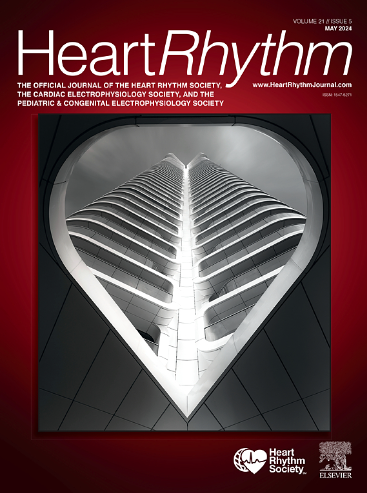经导管主动脉瓣置换术后传导干扰管理的预先指定算法的前瞻性验证。促进研究。
IF 5.7
2区 医学
Q1 CARDIAC & CARDIOVASCULAR SYSTEMS
引用次数: 0
摘要
背景:TAVR术后传导干扰(CDs)的处理存在很大差异。目的:验证一种预先指定的算法来管理TAVR患者的cd。方法:前瞻性多中心研究,包括连续无起搏器患者行TAVR。根据术前是否存在右束支阻滞(RBBB)和手术过程中是否发生CD,将患者分为无既往右束支阻滞和无CD组(NCD组)、既往右束支阻滞和无CD组(RBBB -NCD组)、发生CD组(CD组)。每组预先指定一个管理算法。30天的永久性起搏器(PPM)和死亡率(总体心源性猝死)是主要终点。结果:共纳入2110例TAVR受者。患者分为NCD组(32.0%)、RBBB-NCD组(5.1%)和CD组(62.9%)。共有329例(15.6%)患者在30天内接受了PPM治疗,其中NCD组、RBBB-NCD组和CD组的PPM率分别为5.5%、15.9%和20.7%(结论:在当代TAVR受者中,预先指定的CD管理策略是可行和安全的,没有增加死亡率,并且CD患者的心源性猝死率极低。然而,PPM的比率仍然很高,需要继续努力防止cd的发生。本文章由计算机程序翻译,如有差异,请以英文原文为准。
Prospective validation of a prespecified algorithm for the management of conduction disturbances after transcatheter aortic valve replacement: The PROMOTE study
Background
There is a large variability in the management of conduction disturbances (CDs) after transcatheter aortic valve replacement (TAVR).
Objective
This study aimed to validate a prespecified algorithm for managing CDs in patients undergoing TAVR.
Methods
This was a prospective multicenter study including consecutive patients without prior pacemaker undergoing TAVR. Patients were stratified in different groups according to the presence of prior right bundle branch block (RBBB) and the occurrence of CDs during the procedure: no prior RBBB and no CDs (group NCD), prior RBBB and no CDs (group RBBB-NCD), and occurrence of CDs (group CD). A management algorithm was prespecified for each group. Permanent pacemaker (PPM) and mortality (overall, sudden cardiac death) at 30 days were the primary end points.
Results
A total of 2110 TAVR recipients were included. Patients were distributed in NCD (32.0%), RBBB-NCD (5.1%), and CD (62.9%) groups. A total of 329 patients (15.6%) received a PPM at 30 days, with a PPM rate of 5.5%, 15.9%, and 20.7% in the NCD, RBBB-NCD, and CD groups, respectively (P < .001). The PPM rate was 17.4% and 57.2% in patients with procedural new-onset left bundle branch block and high-degree atrioventricular block/complete heart block, respectively. There were no differences in 30-day all-cause mortality and sudden cardiac death between groups (NCD group, 1.2% and 0.2%; RBBB-NCD group, 0% and 0%; CD group, 0.7% and 0.1%; P = .45 and P = .99 for all-cause mortality and sudden cardiac death, respectively).
Conclusion
A prespecified strategy for the management of CDs in contemporary TAVR recipients was feasible and safe, with no increased mortality and an extremely low rate of sudden cardiac death in patients with CDs. However, PPM rates remained high, and continued efforts for preventing the occurrence of CDs are warranted.
求助全文
通过发布文献求助,成功后即可免费获取论文全文。
去求助
来源期刊

Heart rhythm
医学-心血管系统
CiteScore
10.50
自引率
5.50%
发文量
1465
审稿时长
24 days
期刊介绍:
HeartRhythm, the official Journal of the Heart Rhythm Society and the Cardiac Electrophysiology Society, is a unique journal for fundamental discovery and clinical applicability.
HeartRhythm integrates the entire cardiac electrophysiology (EP) community from basic and clinical academic researchers, private practitioners, engineers, allied professionals, industry, and trainees, all of whom are vital and interdependent members of our EP community.
The Heart Rhythm Society is the international leader in science, education, and advocacy for cardiac arrhythmia professionals and patients, and the primary information resource on heart rhythm disorders. Its mission is to improve the care of patients by promoting research, education, and optimal health care policies and standards.
 求助内容:
求助内容: 应助结果提醒方式:
应助结果提醒方式:


